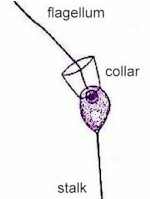..
IMAGES FROM CHAPTER 1 Fig. 1.1. A representation of the Universal Phylogenetic Tree, based on comparisons of the genes encoding small-subunit (16S or 18S) ribosomal RNA. Based on a diagram in Carl Woese (2000) but showing only a few of the major groups of organisms. The lengths of the lines linking organisms to their nearest branch point represent inferred evolutionary distances (rRNA gene sequence divergence). Fig. 1.2. Top row: a present-day “club-moss”, Lycopodium, which represents a primitive member of the ferns (pteridophytes), and two fossil pteridophytes (Asteroxylon mackiei, and Rhynia major) from the Rhynie chert deposits. Bottom row, left: swollen vesicles of a present-day mycorrhizal fungus and (right) similar vesicles of a fossil from the Rhynie deposits. [© Jim Deacon]
Fig. 1.3 (see WWW)
Fig 1.4a Candida albicans, a common dimorphic fungus that grows on the mucosal membranes of humans. Normally it is found as a budding yeast. [© Jim Deacon]
Fig 1.4b Candida albicans: in appropriate conditions, the yeast cells can produce hyphae for invasion of the tissues. [© Jim Deacon]
Fig. 1.5. A sign in Arches National Park, Utah, USA. Get your boots off our microbes! [© Jim Deacon]
Fig. 1.6. Part of a bathroom ceiling where the paint has flaked away, revealing extensive growth and sporulation of sooty moulds. [© Jim Deacon]
Fig. 1.7 (See WWW)
Fig. 1.8a A tray of exotic mushrooms from a supermarket in the U.K., including shiitake (centre) and the oyster mushroom, Pleurotus ostreatus, reputed to be an aphrodisiac. [© Jim Deacon]
Fig 1.8b An attempt to produce a home-made cake of tempeh - a traditional food in Indonesia, made from cooked soybeans and inoculated with the fungus Rhizopus oligosporus. Unfortunately, in the author's hands, this food product tasted only marginally better than it looks. [© Jim Deacon]
Fig 1.9a Quorn (mycoprotein), a novel food source that took 20 years of development. The package shows one of several products: "Fillets in a Mediterranean marinade with tomato, red wine and herbs" [© Jim Deacon]
Fig 1.9b. Quorn - the contents of the package shown in Fig 1.9a.[© Jim Deacon]
Fig. 1.10. Structural similarities between three neurotransmitters (dopamine, noradrenaline and serotonin) and the D-lysergic acid derivatives of ergot alkaloids. [© Jim Deacon] |












